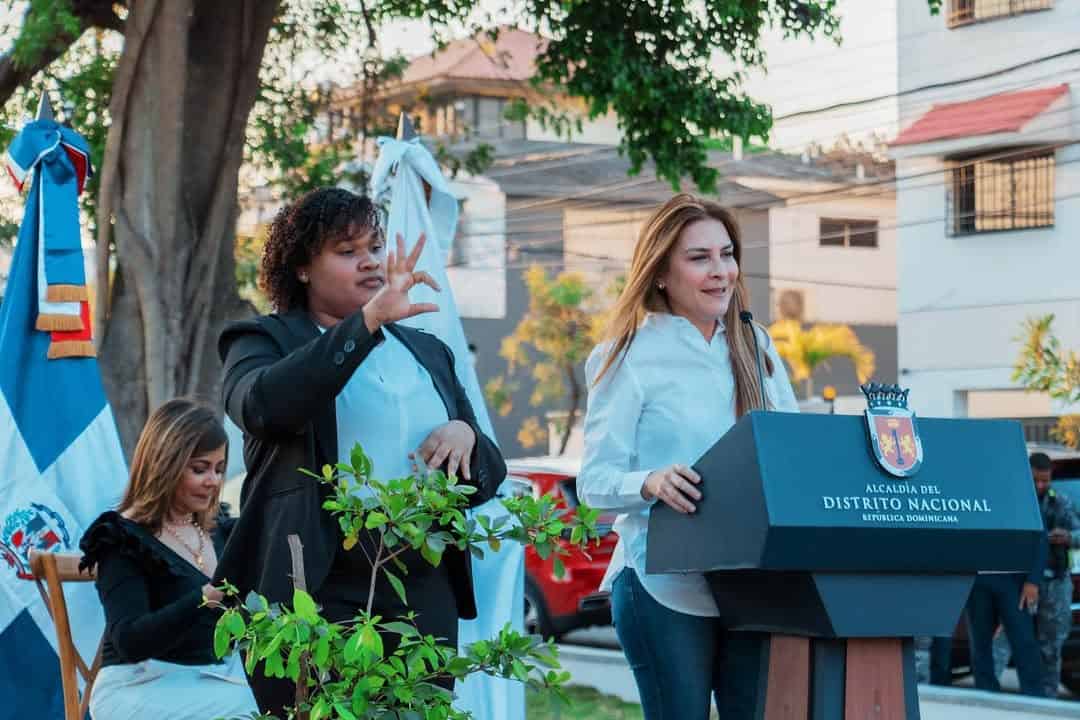The work of a government sign language interpreter

At 24, Merlyna de Jesús is the official interpreter for the National District Mayor's Office 's live broadcasts. At official events, she translates presentations and speeches by figures such as President Luis Abinader and Mayor Carolina Mejía into sign language , aiming to connect the message with the hearing-impaired public.
Before becoming the voice of the deaf for high-profile figures, he prepares to be up to the task. "I always make sure I know roughly what they're going to talk about, what topics they're going to cover, and if they're going to mention names , I always try to know how to spell them," he explains.
When the speech begins, Merlyna appears in a small box on the live stream , usually in the lower right corner of the screen. This is how she appeared during Mejía's 2023 inauguration .
With the same impetus as the mayor in highlighting the achievements of her first three years at the helm of the Primada de América , Merlyna's gestures and expressions materialize to ensure the clarity of her speech.
Beyond the cameras and official stages, she asserts that her work is a way to guarantee rights . According to the study "Social Circumstances of the Deaf Community in the Dominican Republic," published in 2022 by the United States Agency for International Development (USAID), there were around 74,732 households in the country with at least one deaf person at that time.
The educational gap is significant: 35.2% had not attended school or had no education at all, and only 26.8% had completed elementary school.
Your native languageFor many, it may be Spanish, English, or French, but in Merlyna's case, her native language is sign language . Although she can speak, from a young age she became a bridge between hearing and deaf people, a skill she developed at home as a necessity to communicate with her hearing-impaired parents.
While other children were learning to speak, she—who is not hearing impaired —was learning to express herself with her hands, gestures, and body language.
From the age of six months, Merlyna tried to make her first signs , just as babies do when they make their first sounds. Although life inside the home was fluid, it wasn't the same outside.
"When I was little, it wasn't easy because people made fun of me and I was something different... It's very normal for people to be made fun of when they don't know anything," she notes. During her childhood, she faced teasing for communicating differently with her relatives and for the language gap.

One of the points Merlyna highlights during the interview with Diario Libre is the deficiencies in interpreter training in the country. She points out that there are no national programs with the necessary quality for the profession.
Her training required her to travel to several countries, which is reflected in her experience . Merlyna believes there may be many interpreters in the Dominican Republic, but not all of them have the language skills required to work in public institutions .
He believes that, to work as a state interpreter, it must be taken into account that sign language has nuances depending on the country or region, so it is a profession that requires ongoing training.
She also runs her own agency, which provides assistance to deaf people with everyday activities, including universities, banks, and medical offices.
Very little promotionTwo years ago, the Dominican Republic took an important step toward the inclusion of people with hearing disabilities with the enactment of Law 43-23 . However, Merlyna says the effort has been insufficient in its implementation and visibility.
Although regulations recognize the use of sign language as an official means of communication and mandate state authorities to promote its use in public activities , few institutions have incorporated interpreters, either partially or permanently, into official broadcasts.
An analysis of several state payrolls shows that the appointment of interpreters is practically non-existent .
Salaries vary , and contracts are both permanent and temporary. For example, at the National Institute for Early Childhood Care (INAIPI), the sole interpreter earns 50,000 pesos.
There is also an appointment in the Directorate of Government Strategy and Communication (Diecom) , with a fixed salary of 45,000 pesos, and one in the state channel RTVD, where a temporary interpreter receives 26,500 pesos.
Read more
TOPICS -
Diariolibre





